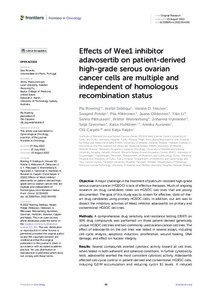| dc.contributor.author | Potdar Swapnil | |
| dc.contributor.author | Heuser Vanina D | |
| dc.contributor.author | Carpén Olli | |
| dc.contributor.author | Auranen Annika | |
| dc.contributor.author | Huhtinen Kaisa | |
| dc.contributor.author | Wennerberg Krister | |
| dc.contributor.author | Grenman Seija | |
| dc.contributor.author | Li Yilin | |
| dc.contributor.author | Siddiqui Arafat | |
| dc.contributor.author | Oikkonen Jaana | |
| dc.contributor.author | Roering Pia | |
| dc.contributor.author | Kaipio Katja | |
| dc.contributor.author | Hynninen Johanna | |
| dc.contributor.author | Pikkusaari Sanna | |
| dc.contributor.author | Mikkonen Pia | |
| dc.date.accessioned | 2022-10-28T14:28:19Z | |
| dc.date.available | 2022-10-28T14:28:19Z | |
| dc.identifier.uri | https://www.utupub.fi/handle/10024/171558 | |
| dc.description.abstract | <p><b>Objective:</b> A major challenge in the treatment of platinum-resistant high-grade serous ovarian cancer (HGSOC) is lack of effective therapies. Much of ongoing research on drug candidates relies on HGSOC cell lines that are poorly documented. The goal of this study was to screen for effective, state-of-the-art drug candidates using primary HGSOC cells. In addition, our aim was to dissect the inhibitory activities of Wee1 inhibitor adavosertib on primary and conventional HGSOC cell lines.</p><p><b>Methods:</b> A comprehensive drug sensitivity and resistance testing (DSRT) on 306 drug compounds was performed on three patient-derived genetically unique HGSOC cell lines and two commonly used ovarian cancer cell lines. The effect of adavosertib on the cell lines was tested in several assays, including cell-cycle analysis, apoptosis induction, proliferation, wound healing, DNA damage, and effect on nuclear integrity.</p><p><b>Results:</b> Several compounds exerted cytotoxic activity toward all cell lines, when tested in both adherent and spheroid conditions. In further cytotoxicity tests, adavosertib exerted the most consistent cytotoxic activity. Adavosertib affected cell-cycle control in patient-derived and conventional HGSOC cells, inducing G2/M accumulation and reducing cyclin B1 levels. It induced apoptosis and inhibited proliferation and migration in all cell lines. Furthermore, the DNA damage marker γH2AX and the number of abnormal cell nuclei were clearly increased following adavosertib treatment. Based on the homologous recombination (HR) signature and functional HR assays of the cell lines, the effects of adavosertib were independent of the cells' HR status.</p><p><b>Conclusion:</b> Our study indicates that Wee1 inhibitor adavosertib affects several critical functions related to proliferation, cell cycle and division, apoptosis, and invasion. Importantly, the effects are consistent in all tested cell lines, including primary HGSOC cells, and independent of the HR status of the cells. Wee1 inhibition may thus provide treatment opportunities especially for patients, whose cancer has acquired resistance to platinum-based chemotherapy or PARP inhibitors.</p> | |
| dc.language.iso | en | |
| dc.title | Effects of Wee1 inhibitor adavosertib on patient-derived high-grade serous ovarian cancer cells are multiple and independent of homologous recombination status | |
| dc.identifier.url | https://doi.org/10.3389/fonc.2022.954430 | |
| dc.identifier.urn | URN:NBN:fi-fe2022102463192 | |
| dc.relation.volume | 12 | |
| dc.contributor.organization | fi=tyks, vsshp|en=tyks, vsshp| | |
| dc.contributor.organization | fi=synnytys- ja naistentautien oppi|en=Obstetrics and Gynaecology| | |
| dc.contributor.organization | fi=biolääketieteen laitos, yhteiset|en=Institute of Biomedicine| | |
| dc.contributor.organization-code | 2607319 | |
| dc.contributor.organization-code | 2607100 | |
| dc.converis.publication-id | 176158340 | |
| dc.converis.url | https://research.utu.fi/converis/portal/Publication/176158340 | |
| dc.identifier.jour-issn | 2234-943X | |
| dc.okm.affiliatedauthor | Huhtinen, Kaisa | |
| dc.okm.affiliatedauthor | Roering, Pia | |
| dc.okm.affiliatedauthor | Hynninen, Johanna | |
| dc.okm.affiliatedauthor | Kaipio, Katja | |
| dc.okm.affiliatedauthor | Siddiqui, Arafat | |
| dc.okm.affiliatedauthor | Grenman, Seija | |
| dc.okm.affiliatedauthor | Dataimport, tyks, vsshp | |
| dc.okm.affiliatedauthor | Dahlström-Heuser, Vanina | |
| dc.okm.discipline | 3122 Cancers | en_GB |
| dc.okm.discipline | 3122 Syöpätaudit | fi_FI |
| dc.okm.internationalcopublication | international co-publication | |
| dc.okm.internationality | International publication | |
| dc.okm.type | Journal article | |
| dc.publisher.country | Sveitsi | fi_FI |
| dc.publisher.country | Switzerland | en_GB |
| dc.publisher.country-code | CH | |
| dc.publisher.place | Switzerland | |
| dc.relation.articlenumber | 954430 | |
| dc.relation.doi | 10.3389/fonc.2022.954430 | |
| dc.relation.ispartofjournal | Frontiers in Oncology | |
| dc.year.issued | 2022 | |
